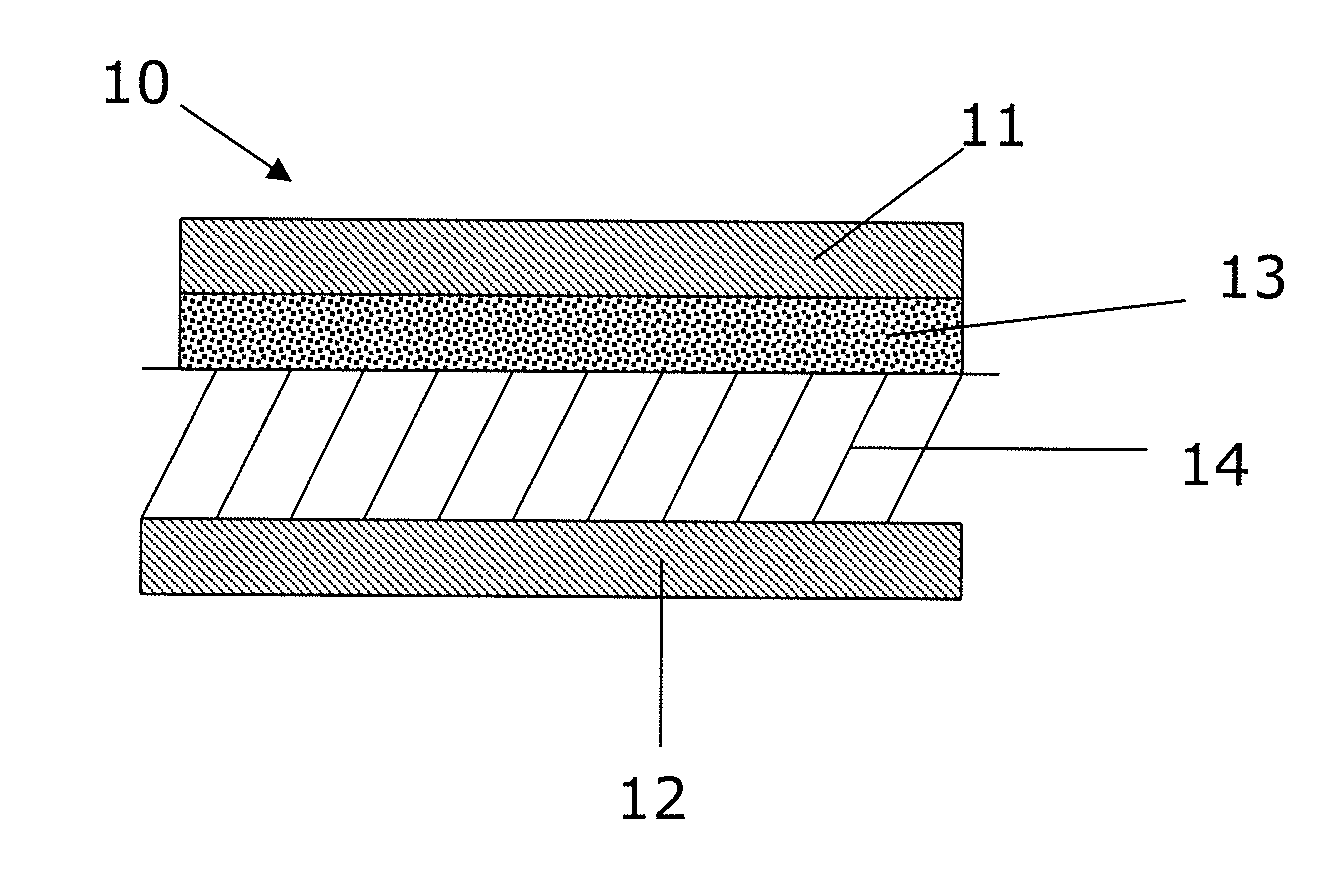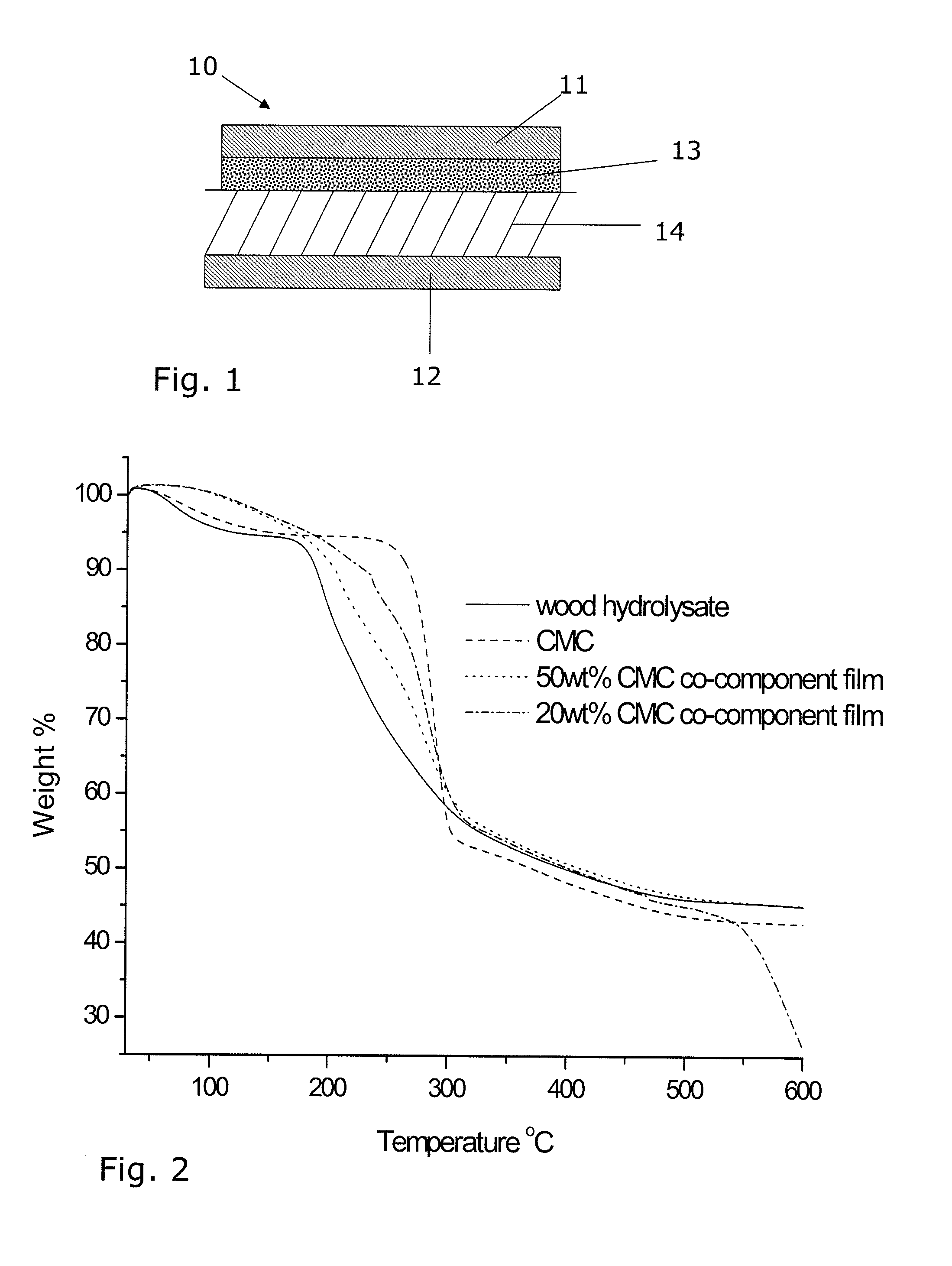Barrier layer for a packaging laminate and packaging laminate comprising such barrier layer
a barrier layer and packaging technology, applied in the direction of packaging, closures, special packaging, etc., can solve the problems of foodtuffs having to be discarded, deteriorating its quality and taste, and damaging the barrier layer
- Summary
- Abstract
- Description
- Claims
- Application Information
AI Technical Summary
Benefits of technology
Problems solved by technology
Method used
Image
Examples
example 1a
[0064]A wood hydrolysate was prepared from spruce, picea abies, according to the method set forth in PCT / EP2008 / 066148. Spruce chips, with dry content 42%, were passed through a laboratory screen grid allowing 8 mm but not 7 mm and then added to a batch autoclave and subjected to steam at 110-120° C. for 45 min. Preheated water was flushed into the autoclave through a pressurized vessel to maintain a liquid-to-wood ratio of 6:1, given as volume-to-mass ratio, and the mixture was heated to 150° C. A representative heating time was 40 min, while the treatment time was 60 min. The total yield of wood components isolated in the hydrolysate was 6.8% with respect to dry matter.
[0065]In the next step, the hydrolysate was upgraded. A volume of 20 litres of the wood hydrolysate was up-graded by fractionation using membrane filtration, in this case ultrafiltration, employing a tangential flow filtration cartridge unit equipped with a regenerated cellulose membrane, PLAC Prepscale, Millipore, ...
example 1b
[0066]A wood hydrolysate was prepared from birch, betula verrucosa, according the method set forth in PCT / EP2008 / 066148. 1.0 kg of dried wood chips with a dry content of 90%, screened on a laboratory screen passing 8 mm but not 2 mm, was charged to a continuous liquid flow autoclave. 5.5 litres of hot water preheated to 165° C. was flushed into the autoclave from a pressurized vessel connected to the autoclave to give a liquid-to-wood ratio of 6:1, given as volume-to-mass ratio. The autoclave was kept at 165° C. for 30 minutes hydrothermal treatment of the wood material. Then about 4.5 litres of the treatment liquid was taken out during approximately 5 minutes and replaced by the corresponding volume preheated water. The about 165° C. hot wood hydrolysate liquid replaced, was collected in a second pressurized vessel connected to the autoclave. The treatment was then continued in the autoclave with the fresh hot water for an additional 30 minutes after which also this second wood hyd...
example 10
[0067]A wood hydrolysate was prepared from a mixture of pine and spruce wood chips in an industrial process for fibreboard production. The wood chips were treated by steam explosion. The aqueous fibre suspension obtained and mixed with processing aids and performance chemicals, was subsequently applied onto the fibreboard machine to form the fibre web, and dewatered. This process water was collected directly after the dewatering step, prior to floatation. This hydrolysate was first subjected to centrifugation, 20 minutes to remove fibre residues and then fractionated by ultrafiltration and diafiltration using the same filter unit as described in Example 1A. The retentate was used for film and coating production as described in forthcoming examples. Optionally, the retentate can be further purified by solvent fractionation in ethanol. A high-molecular weight fraction may then be isolated comprising around 85% of oligo- and polysaccharides and only 3% of lignin (with respect to dry ma...
PUM
| Property | Measurement | Unit |
|---|---|---|
| Thickness | aaaaa | aaaaa |
| Volume | aaaaa | aaaaa |
| Volume | aaaaa | aaaaa |
Abstract
Description
Claims
Application Information
 Login to View More
Login to View More - R&D
- Intellectual Property
- Life Sciences
- Materials
- Tech Scout
- Unparalleled Data Quality
- Higher Quality Content
- 60% Fewer Hallucinations
Browse by: Latest US Patents, China's latest patents, Technical Efficacy Thesaurus, Application Domain, Technology Topic, Popular Technical Reports.
© 2025 PatSnap. All rights reserved.Legal|Privacy policy|Modern Slavery Act Transparency Statement|Sitemap|About US| Contact US: help@patsnap.com


